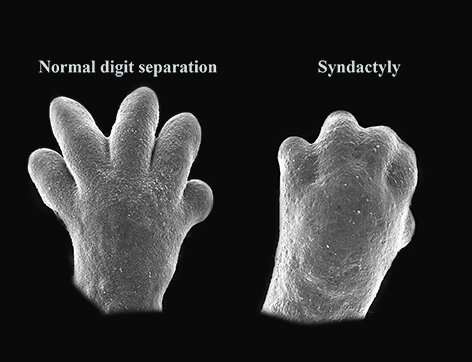 Human fingers are sculpted from a primitive pad-like structure during embryonic development. Sometimes, this process goes awry and babies are born with fused fingers or toes. A new study from the University of California, Irvine reveals new factors involved in the congenital malformation called syndactyly.
Human fingers are sculpted from a primitive pad-like structure during embryonic development. Sometimes, this process goes awry and babies are born with fused fingers or toes. A new study from the University of California, Irvine reveals new factors involved in the congenital malformation called syndactyly.
One of the most common limb malformation in humans, syndactyly was thought to be caused by insufficient removal of the connective tissue between the developing digits. In a study, published today in Developmental Cell, researchers reveal that the overlying skin also plays an active role and is required for sculpting of the digits, and that a layer of non-adhesive cells on the skin’s surface is required to prevent the fusion of adjacent digits.
“Our study identifies epidermal developmental processes required for digit separation that expand beyond the insufficient removal of connective tissue. These additional factors play an integral role in syndactyly and may be implicated in other complex syndromes, including Van der Woude syndrome,” said Ghaidaa Kashgari, PhD, a post-doctoral researcher in the UCI School of Medicine Department of Biological Chemistry, and first author on the paper titled, “Epithelial migration and non-adhesive periderm are required for digit separation during mammalian development.”
Van der Woude syndrome is characterized by cleft lip and/or cleft palate. In addition, seven to eight percent of Van der Woude patients have limb defects, most commonly soft tissue syndactyly which suggests there is a shared developmental mechanism in oral-clefting and digit separation.
“Our research shows that the GRHL3 gene is required for normal digit separation. When this gene is mutated, it can affect the function of the non-adhesive cells on the skin’s surface causing conditions such as Van der Woude syndrome associated with syndactyly as well as cleft lip and palate,” said Bogi Andersen, MD, a professor of medicine and biological chemistry in the UCI School of Medicine, and director of the UCI Skin Biology Resource-based Center.
[“source=sciencedaily”]
